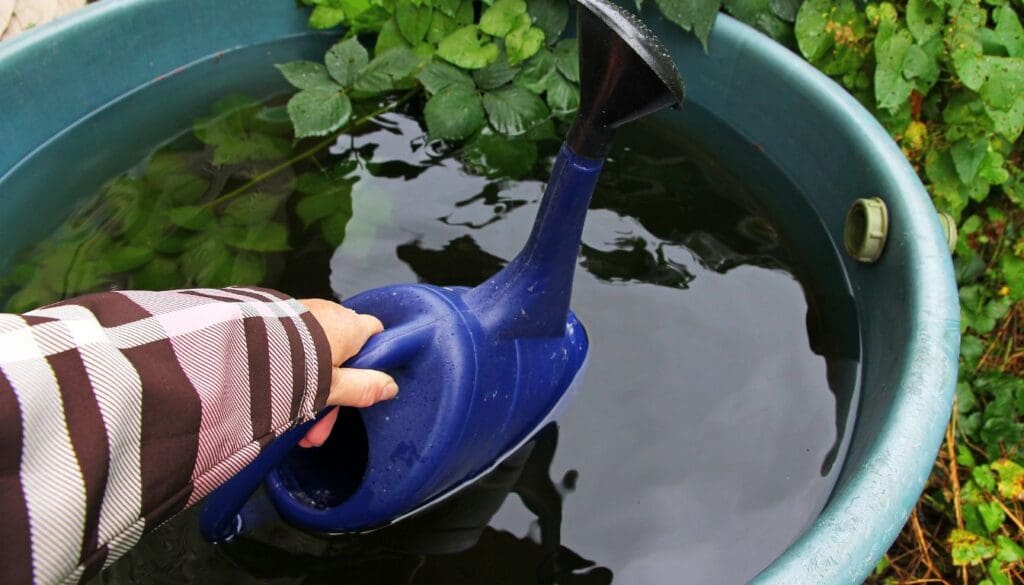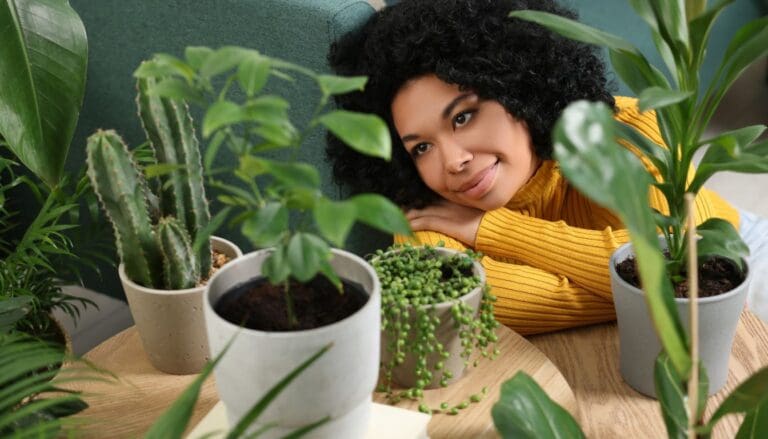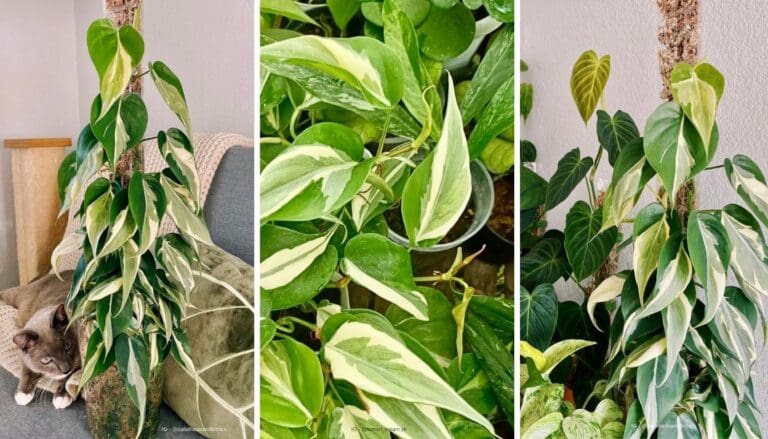Is Tap Water Safe for Your Houseplants?
Have you ever glanced at your houseplants and wondered if the tap water you’re pouring into their pots is actually doing them any good? I mean, plants can’t exactly hold up a sign saying, “Hey, I’m not loving this chlorine vibe!” 😅
It’s a common question bubbling up among plant lovers, so let’s splash right into it!
Here’s the thing: If I can drink my tap water without any creepy crawlies swimming inside, it’s a good bet my leafy buddies can handle it too.
But just like us on a spicy taco night, some plants are a tad more sensitive and might need their water to go through a little detox.
Boiling or letting water sit out for a day can wave goodbye to the chlorine. And if you’re feeling extra – add a dash of vinegar for a pH party!
So, tell me, plant pals, have you noticed your green gang thriving more on tap water, or are they the high-maintenance kind that demand bottled water? 🌱💧
Let me know in the comments – and let’s keep our plant friends’ thirsts quenched and our convos flowing!

Please note: Simplify Plants is reader-supported. Some links in the post are affiliate links and I get a commission from purchases made through links in the post.
What Is Tap Water?
I’ve always wondered where my tap water comes from, haven’t you? Well, let’s turn on the tap of knowledge and let the info flow!
Sources of Tap Water
Most of my tap water comes from two main sources: surface water and ground water.
Surface water includes rivers, lakes, and reservoirs, while ground water is drawn from underground aquifers through wells.
Depending on where you live, the water you use to quench your thirst or shower could have started its journey from a nearby mountain stream or a hidden aquifer deep beneath your feet.
Treatment Processes
Before reaching my tap, this water goes through several treatment steps. Coagulation and sedimentation get rid of the larger particles, while filtration screens out the smaller ones.
Then comes my favorite part – disinfection. I like to think of it as the water’s spa day, where it gets pampered to zap away any harmful microorganisms that might be tagging along.
Common Contaminants
Even though our water is treated, some uninvited guests can still make it through.
Common contaminants in tap water include chlorine, used for disinfection, and fluoride, added for dental health benefits. But sometimes, things like lead or copper can join the party too, especially if I’ve got older pipes.
Don’t worry, though – most of these are present at such low levels that they don’t usually cause problems for us humans.
So there you have it, my curious friends! 🤔 Next time you fill up a glass, think about the journey that water took to reach you.
Got any cool water facts or filter tricks you’d like to share? Drop them in the comments below! 💧🌱
And remember, keep hydrating and stay happy!
Houseplants And Water Quality
Have you ever wondered if the tap water you’re using is giving your leafy friends the TLC they deserve? Let’s get into the nitty-gritty and keep our plants thriving with the right H2O!
Effect of Water Quality on Houseplants

I’m sure you’ve all heard that water quality can be a game-changer for our green buddies. Just like us, plants have a taste for good water—minus the fancy lemon slices, of course! So, what’s in the water matters.
Chlorine and fluoride, common in tap water, might not bother us, but plants can be a bit more finicky—they’re drama queens in disguise. If your tap water is high in these chemicals, it might be time for a switcheroo to filtered or rainwater.
But the plot thickens! Distilled water could leave plants craving those tasty minerals they need.
Signs of Poor Water Quality in Plants
Talk about a plant mystery! 🕵️♂️ If your green buddy isn’t looking too hot, it might be the water.
Look for clues like brown, crispy tips on leaves, which might scream, “I don’t like your tap water, human!” And if you see a weird buildup on the soil, that’s another red flag waving at you.
It’s your cue to play detective and test if your tap water should be on the plant’s menu or voted off the island.
Alright, plant detectives, share your water wisdom! Got any tips or tricks for keeping houseplants happy with top-notch water? Drop them in the comments and let’s get our plant party started! 🌱💧🎉
Benefits of Tap Water for Houseplants
When I water my leafy friends, tap water is my go-to—after all, convenience is key! But, tap water packs some hidden perks beyond just being on tap. Let’s dive into those benefits, shall we? 🌱💧
Minerals and Nutrients in Tap Water
You wouldn’t believe it, but tap water often includes essential minerals like magnesium and calcium—both VIPs for plant health. Think of it as a mini nutrient cocktail for your green buddies.
These minerals help in leaf and stem development. Can you say “growth spurt”?
Convenience and Cost-Effectiveness
Now, who doesn’t love a bit of simplicity and savings? I sure do!
Using tap water means no extra trips to the store for distilled water. And let’s be honest, who doesn’t love saving a few pennies?
Your wallet (and your plants) will thank you. Plus, watering can in one hand, tap in the other—you’re ready to quench some thirst!
Ever had a plant cheering after a sip of good ol’ tap water? Share your stories below! Don’t forget to water wisely and let’s keep our green friends thriving. Got any tips or tricks with tap water? Drop them in the comments! 👇🌿
Potential Risks of Using Tap Water

Let’s dive into why your beloved greens might be giving you the side-eye when you reach for the tap. Knowing these risks can keep your leafy friends happier!
Chlorine and Fluoride Content
I know we’re grateful for chlorine and fluoride in our water for keeping it clean, but plants? Not so much!
These chemicals can prevent plants from doing their best. Chlorine can cause leaf tips to go brown and crispy, while fluoride may lead to a spotted or mottled appearance.
Ever noticed those sad-looking tips on your spider plant? 🕷️ That’s them telling you they’re not fans of these elements.
Hard Water and Salt Buildup
Got hard water? Your plants might not be throwing a party over it.
Hard water is packed with minerals like calcium and magnesium. Sure, they sound healthy, but too much of a good thing can lead to a crusty buildup on the soil, kinda like that limescale on your kettle.
This can block water absorption and say ‘no thank you’ to root growth. So if your water’s harder than doing a Sunday crossword, it might be time to rethink it for your plants! 💪
pH Levels and Houseplant Health
Now, pH levels are like houseplants’ mood rings. Too high or too low, and they’ll definitely show it.
Most houseplants groove to a pH between 6 and 7. However, tap water can often be a little more alkaline.
If you’ve witnessed your plant’s leaves turning yellow, it might be saying, “Hey, check the pH, please!” 🍂
So keeping an eye on that pH can be the secret to keeping your verdant friends vibrant.
Have you seen these signs in your plants? What are your tricks for keeping your green buddies happy with the water you give them? Drop your thoughts in the comments and let’s help each other out! 💧🌱
Pre-treating Tap Water for Houseplants
Ready to give your leafy friends the spa treatment they deserve? I’m going to show you how to pamper those houseplants with some pure hydration goodness. Let’s make sure every drop of water is as refreshing as a rainforest mist! 🌿💧
Methods to Remove Chemicals
I’ve learned a neat trick or two over the years about keeping my plants happy—starting with the water they drink.
Ever heard the rumor that tap water can be a bit of a party pooper for our plant pals? Well, it’s true! The chlorine and fluoride doing wonders for keeping our water clean can make our plants a tad grumpy.
So, how do we fix it? It’s as simple as letting the water sit out for them to gas off.
Give it 24 hours to chill out on the counter, and you’ll have a watering can full of plant-friendly H2O.
Thinking of taking it up a notch? Boiling water is like the detox of the plant world—zap those chemicals right out! 🚰⏰
Adjusting Water Hardness
Oh, and while we’re turning tap water into the ultimate plant cocktail, let’s chat about something called ‘hard water.’
This is water that’s got a bit of a mineral mood, laden with calcium and magnesium. Good for us, maybe not so much for some sensitive green buddies.
Here’s a quick fix: Try using cold, pre-boiled water to give your plants that smooth, soft water feel. It’s like giving them a gourmet drink over tap water takeout!
And if you’re in the mood to experiment, adding a tiny bit of vinegar can tweak the pH just right. Remember, just a teaspoon for every quarter of water, so you don’t overdo it and have your plants pucker up! 🌱➡️💪
That’s the tea on pre-treating tap water—or should I say, that’s the water on it?
Now, don’t keep these tips to yourself. Share your experience below, and let me know how your plant babies are thriving! Can you tell the difference? Drop a comment, I’m all ears! 🌟👇
Alternatives to Tap Water
Ever found yourself late at night, watering can in hand, and wondering, “Is there something better I could be using than tap water?” Well, you’re in luck! I’m about to spill the beans on some top-notch H2O options for your green buddies. 🌿💧
Rainwater

Rainwater is like a spa day for your plants! It’s naturally soft and free from the minerals and chemicals often found in tap water.
Catching rainwater can be as easy as placing a clean bucket outside during a downpour. Just make sure you’re not collecting from a rooftop that might introduce unwanted nasties to the mix.
Distilled Water
Now, let’s talk distilled water! It’s the purest form of water, stripped of all impurities and minerals—it’s like giving your plants a clean slate!
I find it perfect for those fussy ferns that turn up their fronds at anything but the best. Grab it at your local store or invest in a distiller to make your own at home.
Filtered Water
If you’re a fan of gadgets, then filtered water might be your jam. Water filters can range from simple jug filters to fancy under-the-sink units.
They’re great for removing chemicals from tap water, making it more plant-friendly. Plus, filtering water can be more cost-effective in the long run, and who doesn’t love saving some green while being green? 🌱💰
Remember, the best H2O for your potted pals might be just a cloud away or hiding in your cupboard waiting to be used. Don’t let your plants thirst for better care—experiment with these alternatives and listen to what your leaves are telling you!
And hey, share your water wisdom in the comments. What’s your go-to for watering those leafy friends?

How to Test Water Suitability for Plants
Here are a few ways to test the water:
Home Testing Kits
Eager to play scientist with your H2O?
Home testing kits are your DIY gateway to uncovering what’s really in your tap water.
They’re super easy to use—I just follow the included instructions to analyze pH levels, chlorine content, and more.
Usually, you can find these kits at your local hardware store or online.
It’s like a mini lab for your kitchen table! 🌿🔬
Professional Water Testing Services
For those things I might miss, professional water testing services step in to save the day.
They offer a detailed water quality report that can highlight anything from mineral content to potential contaminants.
While it might sound fancy, it’s just taking that extra step to ensure our green buddies thrive.
Sometimes, calling in the pros gives me that peace of mind, knowing my plants are sipping on nothing but the best. 💧💼
Best Practices for Watering Houseplants
When it comes to keeping our leafy pals thriving, getting watering just right is key. Let’s talk about the how-tos that will turn you into the ultimate plant whisperer! 🌱
Watering Frequency and Methods
Have you ever wondered, “How often should I really water my plants?” The truth is, there’s no one-size-fits-all answer.
It depends on factors like the type of plant, the size of the pot, and the environment.
- Listen to Your Plants: Some plants droop when thirsty, so keep an eye out for those sad leaves! 🍂
- Check the Soil: Stick your finger about an inch deep—if it’s dry, it’s time to water.
- Let Water Sit: Chlorine and fluoride don’t make plant-friendly cocktails. Let tap water sit for 24 hours to let these chemicals evaporate. 💧
- Methods Matter: Use room-temp water and consider bottom-watering for even hydration.
- Plants love a good spa-day without the salts, so avoid softened water.
Seasonal Considerations
Seasons change and so do the needs of our green companions. Here’s how to adjust your watering strategy with the seasons:
- Summer – Can you feel the heat? Your plants do too. They’ll likely need more frequent watering as they bask in the sun. ☀️
- Winter – As plants chill out during cooler months, they need less hydration.
- Lower your watering frequency and maybe give them a cozy spot away from cold drafts. ❄️
FAQs
Have you ever wondered if tap water is a friend or foe to your beloved green buddies? Let’s dive into some FAQs!
Can I use tap water to water my houseplants?
Absolutely! If I can sip it, my plants probably can too. But hey, check if it’s safe for human consumption first. If you’re giving it a side-eye, maybe your plants should too.
What if my tap water is treated with chlorine?
No stress! Just let it sit out for 24 hours, and voilà, chlorine takes a hike. 🚶♂️
Tap water pH worries, what’s the deal?
Fear not! A splash of vinegar can rebalance things. I go by 1 teaspoon per quarter (¼) of water once a month.
But my plants are picky!
I hear you. Some plants are divas 🌸, and they’re sensitive to water quality. If that’s the case, using filtered or distilled water can be your peace treaty.
How often should I water with tap water?
It’s like asking how often to feed a cat 🐱 — it depends! Check your plant’s needs; they can be as unique as people.
Conclusion
Well, my green-thumbed friends, the verdict is in! Tap water is generally safe for houseplants, and let’s face it, it’s super convenient. 😌
Just remember to give it some time to sit and de-chlorinate if you want to pamper your leafy pals. No need to get scientific about it, a day on the counter and your tap water is basically a spa treatment for your plants.
Prefer a quick fix? A little vinegar can work wonders on the water’s acidity – just a teaspoon per quarter of water does the trick.
And when in doubt, a good old boil can zappity-zap those excess minerals away. But hey, no pressure if these steps feel extra; I’ve been watering mine straight from the tap, and they haven’t complained yet! 🌱💧
Got a plant that’s a bit more high-maintenance? Flushing out mineral buildup yearly is like a reset button.
A gentle stream of water through the soil, and voilà, it’s goodbye, salty crust!
Let’s face it, we’re not all rain collectors, but if you can catch some, your plants will love you for it. Just beware of that sneaky acid rain in some areas!
Have you tried these tips, or do you have your own watering hacks? Spill the tea (or should I say water?) in the comments!
And if this was news to you, go ahead, share the wisdom with your plant-loving buddies! 🌿🎉
Recommended Garden Supplies
| Product Image | Our Recommended Gardening Supplies | Check Offers! |
|---|---|---|
Top Top
Top
Top
Top
Top
Top
Top
Top | rePotme Houseplant and Tropical Classic Potting Soil Mix | Check Offer On Amazon |
 Top
Top
Top
Top
Top
Top
Top
Top | Espoma Organic Indoor Plant Food | Check Offer On Amazon |
 Top
Top
Top
Top
Top
Top
Top
Top | GooingTop LED Grow Light 6000K Full Spectrum Clip Plant Growing Lamp | Check Offer On Amazon |
 Top
Top
Top
Top
Top
Top
Top
Top | Soil Moisture Meter | Check Offer On Amazon |
 Top
Top
Top
Top
Top
Top
Top
Top | Govee Hygrometer Thermometer, Bluetooth Enabled! | Check Offer On Amazon |
 Top
Top | LEVOIT Humidifiers for Large Room(Best For Plants) | Check Offer On Amazon |
 Top
Top
Top
Top
Top
Top
Top
Top | Upgraded DIY Automatic Drip Irrigation Kit, 15 Potted Houseplants Support | Check Offer On Amazon |
 Top
Top
Top
Top
Top
Top
Top
Top | Stainless Steel Heavy Duty Gardening Tool Set | Check Offer On Amazon |
 Top
Top
Top
Top
Top
Top
Top
Top | Bonide Insecticidal Soap | Check Offer On Amazon |
 Top
Top
Top
Top
Top
Top
Top
Top | Bonide 32 oz Spray Neem Oil for Organic Gardening | Check Offer On Amazon |
 Top
Top
Top
Top
Top
Top
Top
Top | Garden Safe Fungicide | Check Offer On Amazon |






